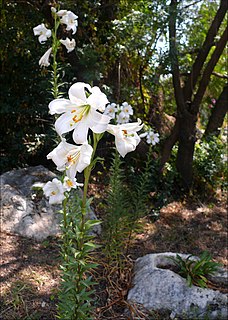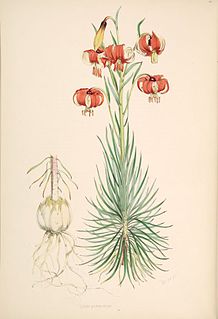
Lilium lancifolium is an Asian species of lily, native to China, Japan, Korea, and the Russian Far East. It is widely planted as an ornamental because of its showy orange-and-black flowers, and sporadically occurs as a garden escapee in North America, particularly the eastern United States including New England, and has made incursions into some southern states such as Georgia.

Lilium is a genus of herbaceous flowering plants growing from bulbs, all with large prominent flowers. They are the true lilies. Lilies are a group of flowering plants which are important in culture and literature in much of the world. Most species are native to the temperate northern hemisphere, though their range extends into the northern subtropics. Many other plants have "lily" in their common names, but do not belong to the same genus and are therefore not true lilies.

The lily family, Liliaceae, consists of about 15 genera and 610 species of flowering plants within the order Liliales. They are monocotyledonous, perennial, herbaceous, often bulbous geophytes. Plants in this family have evolved with a fair amount of morphological diversity despite genetic similarity. Common characteristics include large flowers with parts arranged in threes: with six colored or patterned petaloid tepals arranged in two whorls, six stamens and a superior ovary. The leaves are linear in shape, with their veins usually arranged parallel to the edges, single and arranged alternating on the stem, or in a rosette at the base. Most species are grown from bulbs, although some have rhizomes. First described in 1789, the lily family became a paraphyletic "catch-all" (wastebasket) group of petaloid monocots that did not fit into other families and included a great number of genera now included in other families and in some cases in other orders. Consequently, many sources and descriptions labelled "Liliaceae" deal with the broader sense of the family.

Lilium candidum, the Madonna lily, or white lily is a plant in the true lily family. It is native to the Balkans and Middle East, and naturalized in other parts of Europe, including France, Italy, and Ukraine, and in North Africa, the Canary Islands, Mexico, and other regions. It has been cultivated since antiquity, for at least 3,000 years, and has great symbolic value since then for many cultures. It is susceptible to several virus diseases common to lilies, and especially to Botrytis fungus. One technique to avoid problems with viruses is to grow plants from seed instead of bulblets.

Lilium longiflorum, often called the Easter lily, is a plant endemic to both Taiwan and Ryukyu Islands (Japan). Lilium formosanum, a closely related species from Taiwan, has been treated as a variety of Easter lily in the past. It is a stem rooting lily, growing up to 1 m high. It bears a number of trumpet shaped, white, fragrant, and outward facing flowers.

Lilium philadelphicum, also known as the wood lily, Philadelphia lily, prairie lily, or western red lily, is a perennial species of lily native to North America.

Lilium martagon, the martagon lily or Turk's cap lily, is a Eurasian species of lily. It has a widespread native region extending from Portugal east through Europe and Asia as far east as Mongolia.

Lilium speciosum is an East Asian species of plants in the lily family. It is native to southern Japan and southern China, where it can be found at elevations of 600–900 metres (2,000–3,000 ft). It is sometimes called the Japanese lily though there are other species with this common name.

Lilium pardalinum, also known as the leopard lily or panther lily, is a flowering bulbous perennial plant in the lily family, native to Oregon, California, and Baja California. It usually grows in damp areas. Its range includes California chaparral and woodlands habitats and the Sierra Nevada.

Arum is a genus of flowering plants in the family Araceae, native to Europe, northern Africa, and western and central Asia, with the highest species diversity in the Mediterranean region. Frequently called arum lilies, they are not closely related to the true lilies Lilium. Plants in closely related Zantedeschia are also called "arum lilies".

The dun-bar is a moth of the family Noctuidae. It is a common Palearctic species.

Lilium superbum is a species of true lily native to the eastern and central regions of North America. Common names include Turk's cap lily, turban lily, swamp lily, lily royal, or American tiger lily. The native range of the species extends from southern New Hampshire, Massachusetts, and New York, west to Illinois, Missouri, and Arkansas, and south to Georgia, Alabama, Mississippi, and Florida.

Lilium pomponium, the turban lily, is a European species of lily native to France, Spain, and Italy.

Lilium parryi, common name lemon lily, is a rare species of lily.

Lilium pumilum is an Asian species of bulbous plants native to Mongolia, Siberia, the Russian Far East, Korea and northern China.

Lilium iridollae is a species of Lilium or lily. It is a perennial forb. This species is considered one of five known Lilium species native to specific sites in the United States' southeast region. In 1940, this species was discovered by Mary Henry in its habitat. She named the lily in reference to a "pot of gold at the end of the rainbow".

Lilium hansonii, known as Hanson's lily and Japanese turk's-cap lily, is an East Asian species of plants in the lily family. It is native to Korea, Japan, and to Jilin Province in northeastern China, as well as being widely cultivated as an ornamental.

Lilium pyrophilum, the sandhills lily, is a North American species of plant in the lily family. It is endemic to the Sandhills region of southern Virginia, North Carolina and northern South Carolina, in the eastern United States.
Lilium sherriffiae is a species of Lilium native to Bhutan and Nepal in southeastern Asia.

Lilium polyphyllum is a species of lily endemic to montane environments in central Asia.



















